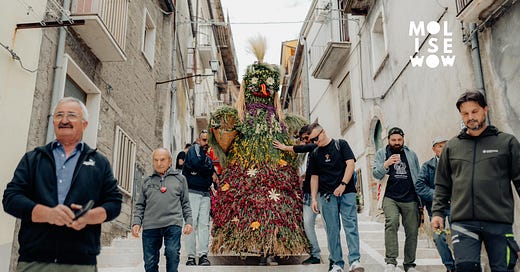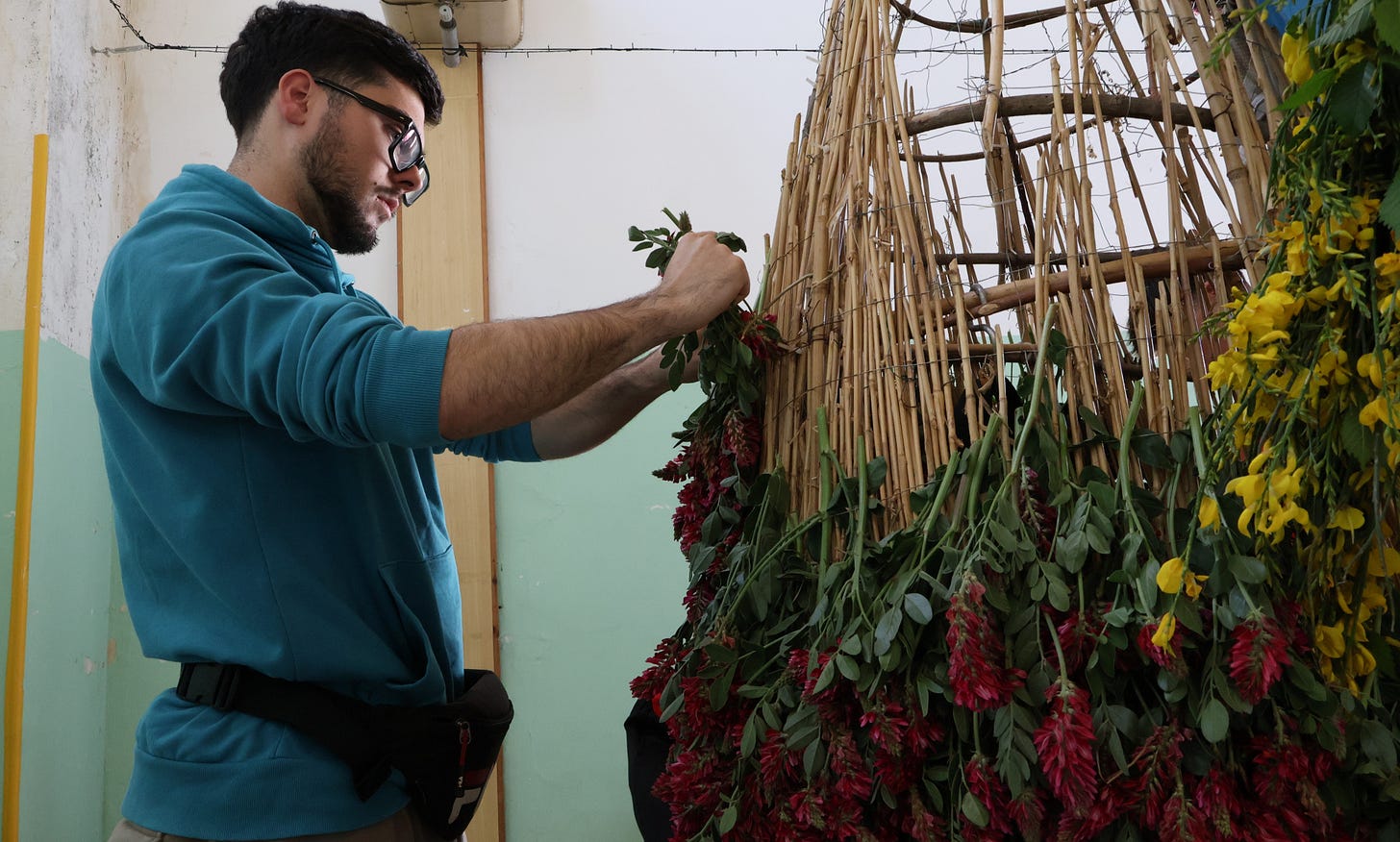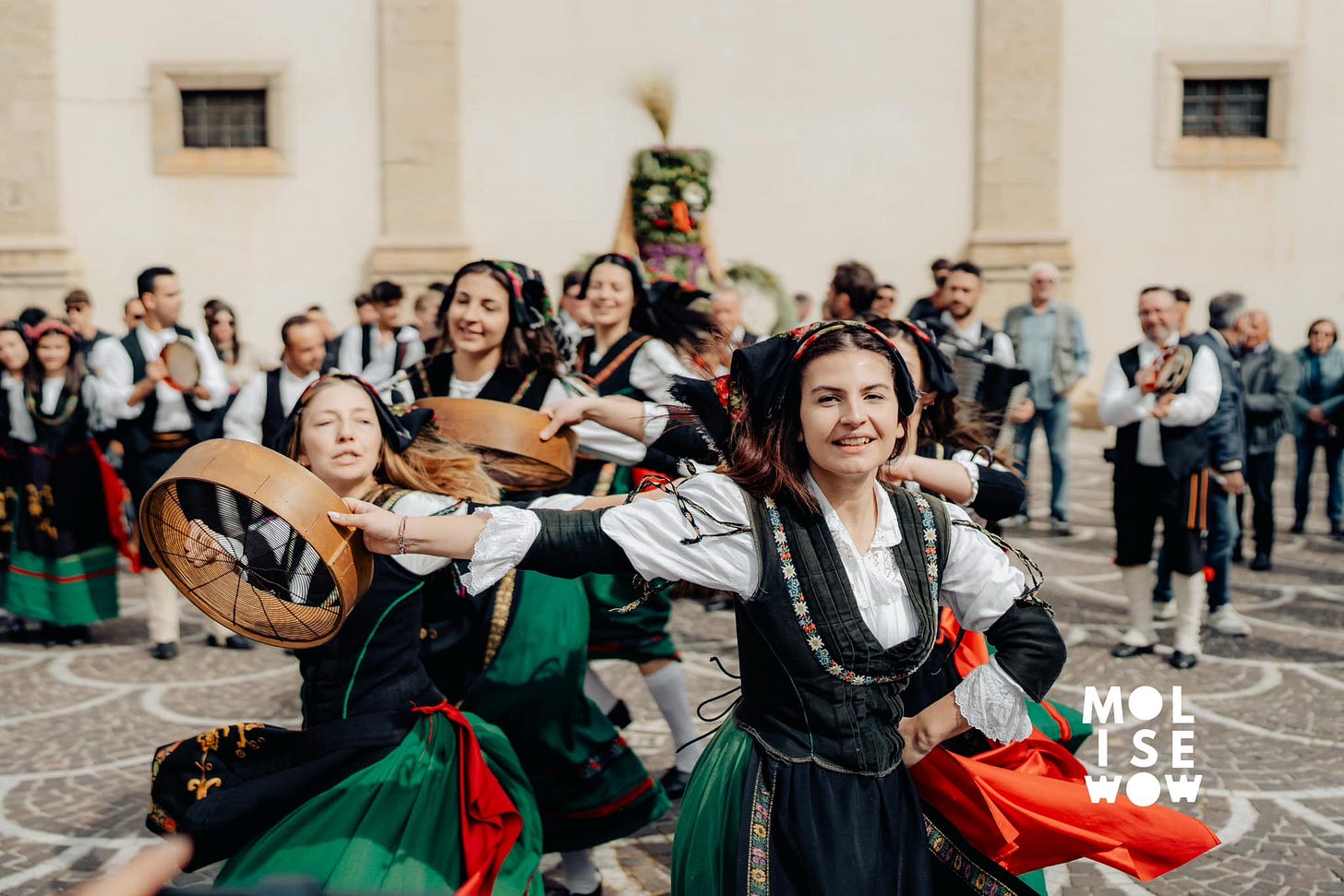S5E19. The Croat spring in southern Italy
On 1st May, the long-established Molise Croat community celebrate an ancient tradition with a parade, displaying a flower-covered puppet with anthropomorphic features. This is the 'Feast of Maja'
Dear reader,
welcome back to BarBalkans, the newsletter with blurred boundaries.
It is a cone-shaped figure that resembles a human: with eyes, a nose, a mouth, long blond hair, and a brightly coloured dress. Standing over two metres tall, it is decorated with flowers, hay, and wild herbs.
Every 1 May, it is paraded through the village, followed by a lively crowd dancing to folk songs and the sounds of traditional instruments.
This is the Maj—the quintessential symbol of spring, harvest, and the rebirth of nature. It stands as the most iconic emblem of the Croatian community that has lived for centuries on the other side of the Adriatic, in the small villages of Southern Italy.
The Feast of Maja in Acquaviva Collecroce (Molise) is a vivid example of how ancient pagan rites—tied to seasonal cycles and the fertility of the land—have survived through the ages, kept alive in local festivals and folk traditions.
In the case of the Feast of Maja, there is an even more unique element. Thanks to the centuries-old presence of the Croatian ethnic and linguistic minority in Molise, this heritage draws both from Italic peoples and Slavic peoples.
Today, Oscar Vetta—town councillor of Acquaviva Collecroce and member of the Naš Život cultural association, that has been reviving this tradition for 25 years—share with BarBalkans what the Feast of Maja means to this community.
BarBalkans is a newsletter powered by The New Union Post. Your support is essential to ensure the entire editorial project continues producing original content while remaining free and accessible to everyone.
Croats from across the Adriatic
“The presence of Croats in Molise dates back to the time of the Ottoman invasions of the Balkan peninsula,” Vetta explains, outlining the centuries-old presence of this ethnic and linguistic community in southern Italy.
Following the Battle of Kosovo Polje in 1389 and the fall of Constantinople in 1453—key moments that marked the expansion of the Ottoman Empire into south-eastern Europe—some Slavic and Albanian people fled across the Adriatic to the Italian peninsula between the late 15th and early 16th centuries.
“There, they found a relatively favourable situation,” Naš Život member points out. The inland areas of Molise “had been left abandoned and depopulated, largely due to the earthquake of 1456 and the plague of 1495.”
This is why, thanks to the policies of the Kingdom of Naples—which encouraged such settlements, including halving the taxes owed to the Crown—meant the Slavic newcomers “did not remain on the coast, but were resettled in the depopulated countryside to work the land.”
Over time, they also moved into the towns, rebuilding abandoned villages (such as Acquaviva Collecroce itself), and repopulating an area “so isolated over the centuries that it allowed them to preserve their original Slavic language.”
Read also: S2E32. Journey to extinguished countries
This is why, even today, this ancient Slavic language is still spoken in parts of southern Italy. Once used across central Dalmatia and Herzegovina, it resembles modern Croatian, but remains very distinct. “We can only understand Croatians if we stick to simple concepts and speak very slowly,” Vetta explains.
Transmitted orally for over five centuries, this language now survives mainly in close-knit family and personal contexts, and only in a handful of small villages.
In Acquaviva Collecroce (home to around 500 people), the language is spoken “up to the generation of those in their thirties.” It also survives in Montemitro (less than 300 residents), and in San Felice del Molise (500), where “just a few elderly people still remember it, though they have no one left to speak it with.” There are also historical traces in Tavenna and Palata, which “received official recognition late from Italian legislation, but the language was lost centuries ago.”
“Those of us who have studied standard Croatian—as well as Croatians who speak Italian—can often trace the roots of the words we use and identify the influence of Italian language and local dialects,” Vetta notes.
Linguists, for example, have found that while the Molise Croats have preserved nearly all the Slavic terminology related to agriculture, the words for crops introduced from the Americas in the 16th century—such as potatoes, tomatoes, and maize—show no connection to modern Croatian.
A celebration of rebirth
The Feast of Maja is when the spirit of the Croatian community in Molise truly comes to life and is reaffirmed. Though centuries old and deeply rooted in local folk culture, this tradition carries a surprisingly contemporary relevance.
“The earliest record we have,” explains Vetta, “is a mid-19th-century exchange of letters between a local literature professor and a Croatian poet who had taken an interest in the cultural and linguistic traditions of this linguistic minority.”
The first photographic evidence dates back to the early 20th century, “when a linguist studying the Croatian community included a photograph of the puppet in his publication.”
The tradition faded during the Second World War and the post-war years, before being briefly revived in the 1980s. “But only for a short time,” Vetta adds. Since 2000, however, a new cultural association, Naš Život, has brought the celebration back to life each year, “under the guidance of Professor Giovanni Piccoli, the village historian.”
What exactly is the Feast of Maja?
A few days before the parade, a group of locals collect flowers and wild herbs from the countryside around the village of Acquaviva Collecroce. On the afternoon of 30 April—the eve of the celebration—“we dress the puppet,” Vetta explains. This means decorating the cone-shaped structure with flowers and herbs, giving it human-like features.
The festival itself takes place on 1 May (Maj/Maja means exactly ‘May’).
A person steps inside the decorated structure and carries the Maj to the village square, marking the start of the annual tradition.
“We all join the parade through the streets of the village,” Vetta continues, “accompanied by folk songs, traditional dances, instruments—and, in recent years, even organised folk groups. The festival has grown considerably.”
During the procession, some residents open their homes to offer free food and wine to those taking part in or watching the parade. “They prepare traditional dishes like asparagus omelette, fried pasta, and bruschetta with chilli,” Vetta says. “Even local businesses have started to get involved.”
This custom echoes an older tradition, when poorer villagers would ask local landowners to throw food from their windows and balconies—a gesture that lives on in the most iconic song of the Feast of Maja:
“Who said May would never come? Come outside and see it pass.
Chorus: Our fine lords, throw us something! We are your people.May has brought us beautiful days. I see your trees, their branches full!
ChorusI see your lands full of grass. I see your sheep heavy with wool!
ChorusMy beautiful vine, you will bear much fruit; you will lead me on my way!
ChorusI see the sieve! Welcome, summer! I see the cupboards—your barrels full of wine!
ChorusMay God protect our villages and our doorsteps! Health to you and all your children!
Chorus”
What we know about the Feast of Maja is that “it was a springtime propitiatory ritual and a way of giving thanks to nature for its gifts,” Vetta points out.
The festival can be traced to two distinct but remarkably similar folk traditions, despite their geographical distance. These traditions became intertwined over time, thanks to the presence of the Croat community in Molise—so much so that it is difficult to say which one influenced the other.
On one side are the arboreal cults of the ancient Italic peoples: the worship of the goddess Flora, protector of agriculture; the Roman festival of Robigalia, held on 25 April; and the Catholic Rogation Days—morning processions that, from the 4th century onwards, replaced the pagan Ambarvalia, rituals intended to bless the agricultural year.
On the other side are the spring rites of the Balkan peoples. The Slovenian/Croatian tradition of Zelený Juraj (‘Green George’), associated with the feast of St George on 23 April, is celebrated in ways strikingly similar to those in Molise—including a folkloric puppet figure adorned with herbs and flowers, and given anthropomorphic features.
Nowadays, the Feast of Maja is more than just a tribute to ancient traditions. It holds vital meaning for a small town grappling with the same challenges faced by many rural communities in southern Italy.
“In recent years, the festival has grown so much that it draws visitors from outside”—Naš Život member recalls—“but above all, it brings back those who have left.” Many former residents of Acquaviva Collecroce “make a point of returning on this occasion, just to be together.”
In short, the sense of belonging fostered by the Feast of Maja “brings renewed life to a village in decline—where few young people remain, and many of those who do eventually move away.”
Read also: S2E17. The Balkans in Naples
Pit stop. Sittin’ at the BarBalkans
We have reached the end of this piece of the road.
Today at our bar, the BarBalkans, we find only what the citizens of Acquaviva Collecroce bring and share throughout the day of celebration.
“Wine, without a doubt—this is the drink that has always been part of local tradition,” says Vetta, sharing an anecdote from the 2025 edition. “Like two years ago, we printed Maj-themed T-shirts. This time they were white instead of black, and people complained, because you could see the wine stains on them!”
Read also: S4E13. Gastronationalism tastes like nothing
Let’s continue BarBalkans journey. We will meet again in two weeks, for the 20th stop of this season.
A big hug and have a good journey!
Behind every original product comes an investment of time, energy and dedication. With your support The New Union Post will be able to elaborate new ideas, articles, and interviews, including within BarBalkans newsletter.
Every second Wednesday of the month you will receive a monthly article-podcast on the Yugoslav Wars, to find out what was happening in the Balkans 30 years ago.
You can listen to the preview of The Yugoslav Wars every month on Spreaker.
Discover Pomegranates, the newsletter on Armenia and Georgia’s European path powered by The New Union Post
If you no longer want to receive all BarBalkans newsletters, you can manage your preferences through Account settings. There is no need to unsubscribe from all the newsletters, just choose the products you prefer!











